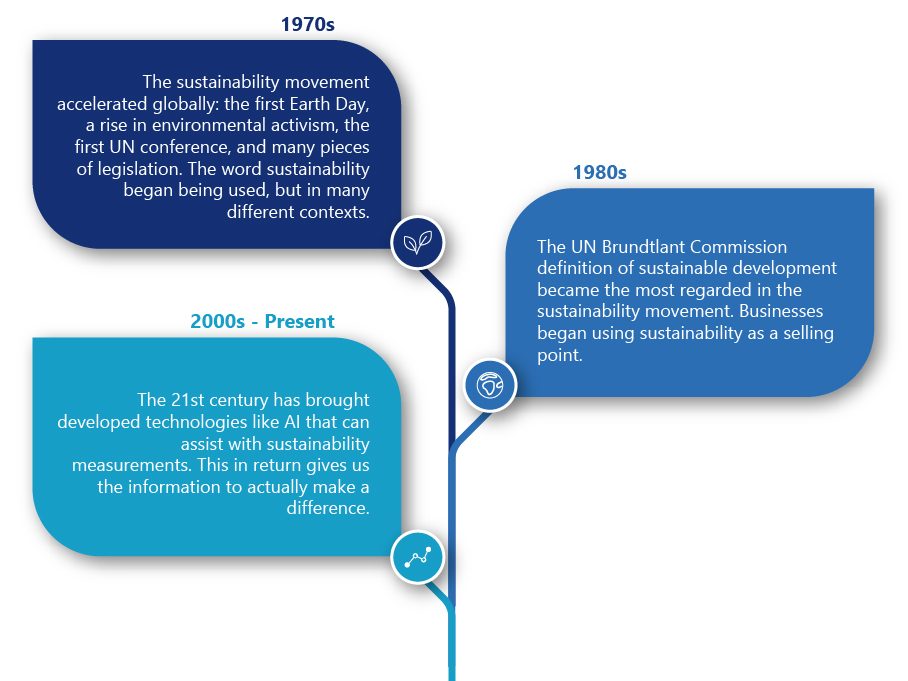Blog
“Sustainability” A historical approach that meets AI.

The first glimpse of sustainability in the modern era was introduced in the 1970s by a special edition of The Ecologist called Blueprint for Survival. The Blueprint involved the work of over 30 world-leading scientists of the day, some of whom were well-known environmental authors like Edward Goldsmith and Robert Allen. The unanimous mindset of these scientists urged a radically restructured approach in order to prevent a total collapse of society and irreversible disruption of the critical systems on the planet. They recommended that people live in small decentralised and mainly de-industrialised communities. The authors cited several reasons for their recommendation, including the difficulty of enforcing moral behaviour in large communities, the likelihood of more ecologially sound agricultural and business practices in smaller communities, and the greater sense of fulfillment that people experienced in smaller communities. Additionally, reducing the population of an area could reduce its environmental impact.

Sustaining “the earth’s” ability.
The UN Brundtland Commission Report was published in 1987 which entailed one of the most regarded and simplified definitions of the sustainability revolution. “Sustainable development is development that meets the needs of the present without compromising the ability of future generations to meet their own needs.” The sustainability movement has undergone immense development, from growing concerns for the environment during the industrial revolution to the establishment of global protocols and agreements.
Sustainability in the New Age
The continuous effort to enact legislation, systems and awareness has brought forward a new sustainability movement in the modern world. Our need for effective and comprehensive measures has never been greater. In 2015 almost every country signed the Paris Agreement to try and limit global warming to 1.5˚C. Since then, the digital age has witnessed an explosion in sustainability efforts, leading to new technologies that can assist in providing detailed information to assess Environmental, Social and Governance (ESG) challenges. One example of this is Microsoft Sustainability Manager (MSM), a comprehensive platform created by Microsoft to simplify the process of addressing ESG challenges. MSM drives the digital forefront of sustainability by utilising complex algorithms to calculate absolute metrics that enable companies to track sustainability performance and goals.
How can AI assist?
In the 21st century, the concept of sustainability has evolved to encompass not just the preservation of natural resources, but also the responsible use of technology. Artificial Intelligence (AI), with its transformative potential and growing ubiquity, has become a significant factor in this new definition of sustainability. AI systems, particularly those that are data-intensive, require substantial computational resources. This, in turn, leads to significant energy consumption and carbon emissions. For instance, training a large-scale AI model like GPT-3 is estimated to have a carbon footprint equivalent to driving a car from Earth to the moon and back.
AI as a Catalyst for Sustainability
Despite these challenges, AI also holds immense potential to drive sustainability efforts. AI can contribute to 93% of the environmental targets set by the United Nations. This includes creating smart, low-carbon cities, integrating renewable energy through smart grids, identifying desertification trends via satellite imagery, and combatting marine pollution. Generative AI, a subset of AI, is particularly promising in this regard. It can identify patterns in manufacturing processes to reduce waste, improve air quality by predicting pollution levels, and enhance agricultural yield through precision farming.
Striking a Balance: Sustainable AI
The key challenge lies in balancing the growth of AI with sustainability. This involves promoting energy-efficient AI models and practices. A shift in mindset is required, moving away from the notion that bigger AI models are always better. By focusing on AI applications that promote environmental sustainability, AI can become a valuable ally in the fight against climate change. In conclusion, AI has significantly influenced the definition of sustainability in the 21st century. While it presents certain environmental challenges, it also offers innovative solutions for sustainable development. The future of sustainability will depend on how effectively we can leverage AI while mitigating its environmental
impact. One of our core values at 4Sight is to support the sustainability movement and help our customers achieve their environmental, social and governance (ESG) goals. We understand that sustainability is not only a moral duty, but also a competitive advantage in the market. That’s why we have a dedicated team of experts in research and design who can provide innovative solutions for any sustainability challenges. We also leverage advanced solutions like Microsoft Sustainability Manager to measure and manage ESG targets that can improve our customers’ performance and impact.
By using data-driven strategy and AI-driven sustainability technology, we help our customers create positive change for their businesses and the planet. Contact 4Sight at This email address is being protected from spambots. You need JavaScript enabled to view it.


